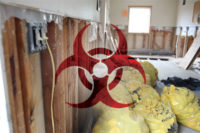What Bio-Remediation Professionals Can Learn from the Ebola Outbreak
The chance of an Ebola outbreak in the U.S. is slim, but it’s a good reminder for biohazard professionals on the importance of properly dealing with bacteria and viruses.






In the news and on the Internet, it’s next to impossible to avoid the mention of “Ebola.” Misinformation and panic characterize much of the discussion, as Americans rightly fear what could happen were the deadly virus to reach our shores. Experts reassure the population that the chances of an Ebola outbreak in the United States is slim to none, while in the meantime, scientists and researchers struggle to develop containment, treatment and vaccination strategies to combat the illness as it continues to decimate less developed nations.
From a remediation perspective, the focus is on cleanup and maintaining high levels of safety for workers in the field. Professional biohazard remediation companies are already well-equipped to handle a host of dangerous bacteria and viruses. They are prepared to perform cleanup and sanitization in a wide variety of situations and conditions. By examining how Ebola cleanup is handled in other countries, service providers can create and improve preparedness strategies at home, and bolster the confidence of customers by providing proven solutions to other serious biohazards.
What is Ebola?
Identified in 1976 in the Democratic Republic of Congo, Ebola took its name from the river where it was originally reported. It is one of several viruses in the filovirus family classified as viral hemorrhagic fevers (VHFs). VHFs affect several of the body’s vital systems and symptoms are often accompanied by bleeding or hemorrhage, though the bleeding itself is rarely life threatening. The more common Lassa fever and Reston virus (an offshoot of Ebola) are two similar types of viruses. While some VHFs cause mild illness, many, like Ebola, lead to severe, even deadly disease. Though almost unheard of outside of Africa, the fear surrounding Ebola is warranted. Statistics show that nearly 90% of Ebola victims die of the illness.
For most Ebola patients, the cause of death is typically shock, brought on by low blood pressure. The Ebola virus is systemic, meaning it attacks every organ in the human body. The only exception is bone and skeletal system. Although it is not known exactly how the virus attacks cells, it is postulated the virus releases proteins that deplete the immune system. The Ebola virus multiplies rapidly, breaking down the collective tissue known as collagen which helps hold internal organs in place. Ebola also causes small blot clots to form in the bloodstream, causing the blood to thicken and slowing the circulation of blood flow to vital organs. Blood clots can lead to blockages in the bloodstream, which may damage or eliminate blood flow to vital organs (brain, liver, lungs, etc.).
Despite efforts to supply accurate information and improve medical facilities in at-risk communities, outbreaks of Ebola continue to increase in frequency and severity. During the most recent outbreak, the World Health Organization (WHO) projects as many as 20,000 people were infected in as little as three months in the West African nations of Liberia, Sierra Leone and Guinea. The WHO estimates that the cost to contain the disease will total over $430 million and could take up to 9 months.
How is it Contracted?
The original animal host for the Ebola virus is thought to be the fruit bat, an animal common in rainforests throughout Africa. Other animals such as gorillas, chimpanzees and antelope may contract the illness as humans do, and subsequently die from it. In general, Ebola is transmitted only through contact with the blood, vomit, feces or other bodily fluids of an infected individual during the time when they are contagious/symptomatic. This includes animal and human carriers.
So what if you find yourself on a crowded subway train or in a hospital waiting room with a victim of Ebola? Could shaking hands or brushing shoulders with an infected person lead to an infection? As with any illness that is transmitted from person to person, the answer is that it is “possible.” Filoviruses are capable of surviving for weeks in blood and can also survive on contaminated surfaces, particularly at low temperatures (4°C). Fortunately, hospitals, particularly those in the US, are regularly sanitized by trained personnel, and the environmental fluctuations in places such as a bus or train station make it an unlikely place to contract the virus.
However, as we all know from experiences with the common cold or influenza, transmission is still possible. Often, it’s just a matter of how widespread the illness becomes. In dealing with a serious and deadly virus like Ebola, it is important for those who handle cleanup and remediation to be educated and trained on the best solutions to help contain and eliminate the virus in the event of an outbreak.
Who is at Risk?
Health care workers are more likely to be exposed to the illness, while those who tend to the deceased (funeral home workers and other emergency personnel) as well as those who are expected to clean up after an outbreak, are also at an increased risk of contracting the virus. In West Africa, hunters, and those who prepare animals potentially infected with Ebola, are also in danger.
Avoiding close physical contact with infected people and their body fluids is the most important way of controlling the spread of any disease. Infection control techniques include isolating infected individuals and wearing personal protective equipment (PPE). Other recommendations include proper use, disinfection, and disposal of instruments and equipment used in treating or caring for infected patients, including needles and thermometers.
For remediation providers, these recommendations could extend to the disposal or sterilization of the tools used to sanitize the affected area. Strict containment procedures should be standard practice when dealing with potential outbreaks. Furthermore, sanitization should be verified through the use of ATP testing or another highly reliable and well-documented medium.
Suggested Procedures
Scientists have demonstrated that Ebola and other related viruses can survive outside the human body for months at a time, given a proper incubation environment. This information is based on experimental findings and not observations in nature. Human transmission and direct contact remain the most likely ways of contracting the illness. Nevertheless, sanitation and cleanup are critical components to controlling an outbreak.
In the event of an Ebola outbreak, biohazard remediation technicians would don full coverage PPE, completely covering all street clothing. Solid-front gowns with tight fitting wrists, gloves, respirators and eye protection are all necessary to provide complete protection from invisible and microscopic viruses.
In order to effectively neutralize and prevent the spread of the Ebola virus, certain precautions are necessary. When it comes to cleaning or removing bodily fluids, different approaches should be conducted based on the situation. For example, all bodily fluids that are affecting porous/absorbent material (cloth, carpet, padding, fabric, etc.) are not able to be cleaned and should be removed and disposed properly. In Africa, biohazard cleanup crews have resorted to burning clothing, bedding and other materials, so that they would not be reused by family members. In the U.S., specific federal or state regulations may dictate the handling of biohazardous materials; professional cleanup companies are familiar with these rules, and operate accordingly.
On non-porous surfaces that can tolerate stronger bleach solutions, such as cement floors, metal tables or tools, the WHO recommends cleaning up spills of blood or body fluids by flooding the area with a 1:10 dilution of 5.25% household bleach for 10 minutes. For surfaces that may corrode or discolor, careful cleaning is advised to remove visible stains, followed by contact with a 1:100 dilution of 5.25% household bleach for more than 10 minutes. For spaces where there is no visible contamination, workers should use a suitable disinfectant and treat the area thoroughly, allowing the prescribed contact time for the solution to work. Fresh, disposable towels should then be used to wipe down the area, starting at the perimeter and working towards the center. If performed properly, the removal of the Ebola virus could be achieved on hard non-porous surfaces through the use of careful cleaning measures like these, followed by the proper application of an EPA-registered disinfectant effective for the elimination of the virus.
As with any biohazard situation, medical waste, including towels, and used PPE, should be placed in sealed, labeled containers and disposed of in accordance with local and federal procedures.
The Future of Cleanup
In West African countries, doctors lack modern medical facilities needed to better treat Ebola, as well as the tools necessary to provide for the full sanitization and cleanup of effected areas. To answer this need, West African nations have begun training professional service personnel to handle body removal, waste disposal and cleanup.
Much like death cleanup technicians in the U.S., the so-called “burial boys” are dedicated to their task, utilizing some of the techniques described here. Professional biohazard remediation continues to be an integral component in stopping the spread of illnesses in the United States and elsewhere. If a cleanup is performed with care, the Ebola virus can be eliminated in a manner similar to other communicable diseases.
Looking for a reprint of this article?
From high-res PDFs to custom plaques, order your copy today!










